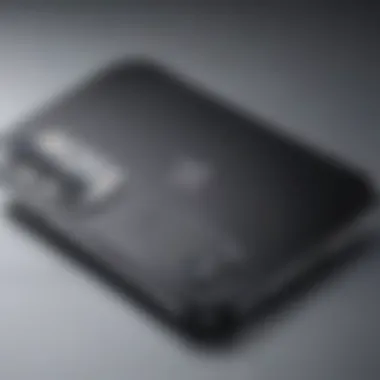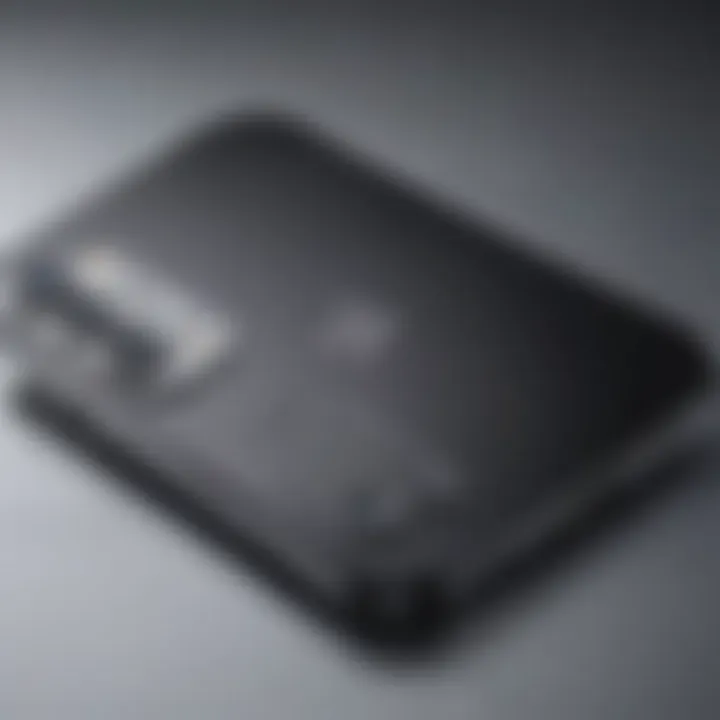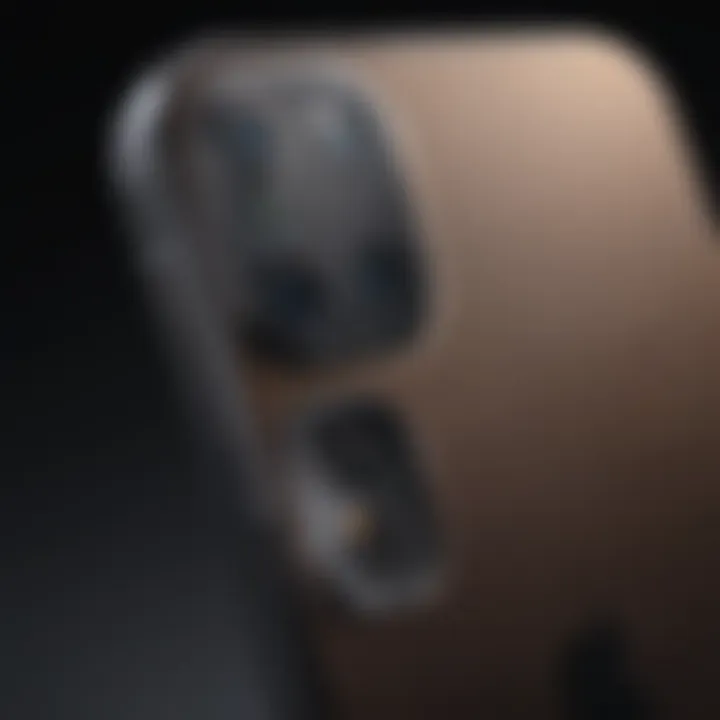In-Depth Analysis of iPhone 12 Pro: Features & Performance


Intro
The iPhone 12 Pro, launched in October 2020, represents a significant advancement within Apple's smartphone lineup. Its introduction marks a pivotal intersection of design innovation and cutting-edge technology. This analysis delves deep into the specifications, features, and user performance, providing a holistic view of what this flagship device brings to the market. The iPhone 12 Pro is not only a technological marvel but also a reflection of current trends in mobile technology and user expectations.
In this article, we will dissect various aspects of the iPhone 12 Pro, examining its design elements, camera systems, processor capabilities, and the seamless integration with iOS. This examination aims to illuminate the broader implications of the iPhone 12 Pro within the competitive landscape of mobile devices, particularly how it enhances the user experience and aligns with Apple's ecosystem. Let's begin by exploring the research overview related to this significant device.
Research Overview
Key Findings
The iPhone 12 Pro showcases a variety of impressive features:
- Design: A premium build with a ceramic shield front cover.
- Camera: Advanced photography capabilities, including night mode and LiDAR scanning.
- Performance: Powered by the A14 Bionic chip, it delivers superior speed and efficiency.
- 5G Connectivity: Speeds up download and streaming experiences.
- User Experience: An intuitive interface allows users to easily access functionalities.
Study Methodology
To compile this analysis, various sources and methods were utilized:
- Literature Review: Existing reviews from trusted tech publications.
- User Feedback: Insights gained from online forums and platforms like Reddit.
- Technical Specifications: Data retrieved from official resources, such as Apple's website.
This comprehensive review integrates both quantitative data and qualitative insights to present a balanced perspective on the iPhone 12 Pro.
Background and Context
Historical Background
The introduction of the iPhone series has consistently reshaped the mobile landscape. The iPhone 12 Pro builds on the legacy of its predecessors, aiming to provide an enhanced user experience while pushing the boundaries of technology. Apple's consistent updates to the iPhone series reflect its commitment to innovation in hardware and software.
Current Trends in the Field
As of late 2020, a notable trend is the shift towards 5G technology. Consumers are increasingly prioritizing devices that offer faster connectivity, alongside the need for improved camera functionalities and overall performance. The intersection of these trends is essential for understanding how the iPhone 12 Pro fits into the broader smartphone market.
"The combination of hardware versatility and software integration is what makes the iPhone 12 Pro stand out among its competitors. Many users feel that it is not just a phone, but an entire ecosystem."
Overall, the iPhone 12 Pro exemplifies Apple's strategic vision of integrating advanced technology with user-centric design. It serves as a bridge between consumer needs and the technological possibilities available today.
Preamble to the iPhone Pro
The iPhone 12 Pro represents a significant leap in the evolution of Apple's smartphone lineup. This introduction seeks to outline the importance of the iPhone 12 Pro within the context of Apple's broader strategy and its impact on the mobile market. Understanding its features and implications is crucial not just for consumers but also for industry analysts and tech enthusiasts.
Overview of Apple's Smartphone Lineup
Apple's smartphone lineup has long set trends in the industry. With the introduction of the iPhone 12 Pro, Apple diversified its offerings to include a premium device that caters to both casual users and professional creators. The iPhone 12 series as a whole focused on 5G connectivity, enhanced camera systems, and improved processing capabilities, which all resonate well with current tech demands.
What distinguishes the iPhone 12 Pro is its position as the flagship model among Apple's smartphone offerings. Unlike the standard iPhone 12, the Pro version offers advanced features such as improved camera technology and a premium design. This aligns with Apple's objective to position itself as a leader in high-end smartphones.
Significance of the iPhone Pro Release
The release of the iPhone 12 Pro was a pivotal moment in the smartphone market. This device not only introduced 5G technology to a wider audience but also showcased Apple's continued commitment to innovation. The inclusion of the A14 Bionic chip marked a step forward in performance and efficiency, which is essential for demanding applications and tasks.
Moreover, the iPhone 12 Pro sparked discussions about smartphone capabilities in photography and videography. With features like Night Mode and the ability to shoot in Dolby Vision HDR, the device reached beyond traditional texting and calling functionalities, drawing in photographers and videographers.
Design and Aesthetics
Understanding the design and aesthetics of the iPhone 12 Pro is crucial as these elements greatly influence both user perception and functionality. Apple has always emphasized design in its products, believing that aesthetics contribute to the overall experience. The iPhone 12 Pro not only embodies high-quality materials but also integrates practical features into its elegant design. Every detail is significant, affecting usability, comfort, and visual appeal.
Physical Dimensions and Materials
The physical dimensions of the iPhone 12 Pro stand out as it offers a balance between handheld comfort and a vibrant display. Measuring 146.7 x 71.5 x 7.4 mm, it is slim yet substantial enough to feel durable. The use of surgical-grade stainless steel for the frame enhances the phone’s rigidity while also imparting a premium feel. Additionally, the front features Ceramic Shield, which provides four times better drop performance than its predecessors. This combination of materials means that while the phone is sleek, it does not compromise on durability. The choice of materials not only affects the structural integrity but also enhances the phone's capacity to withstand daily wear and tear.
Color Options and Visual Appeal
Color options play a crucial role in consumer choice and the iPhone 12 Pro does not disappoint in this regard. Available in Graphite, Silver, Gold, and Pacific Blue, each color is crafted to look sophisticated. The finish on these colors reflects light beautifully, adding depth and allure to the device. Users often pick their devices based on color, which can reflect personal style and taste. The visual appeal of the iPhone 12 Pro captures attention and fosters a connection. Ultimately, the design choices made by Apple not only showcase aesthetic quality but also align with the brand's identity of luxury combined with functionality.
"A well-designed smartphone is a blend of art and technology, where every curve and finish fosters user engagement and satisfaction."
Display Technology


Display technology plays a crucial role in the functionality of modern smartphones. In the case of the iPhone 12 Pro, its display serves not only as a visual interface but also enhances the overall user experience. The integration of advanced display features can significantly impact usability and interaction with the device.
Super Retina XDR Display Features
The Super Retina XDR display is one of the standout features of the iPhone 12 Pro. This OLED screen offers incredible brightness levels, achieving peak brightness of up to 1200 nits. This means that users can enjoy vibrant colors and deep blacks, which is especially noticeable when viewing high-quality HDR content.
Another important aspect is the contrast ratio that the display offers, which is 2,000,000:1. Such a high contrast ratio allows for a more immersive viewing experience. Additionally, the screen supports a wide color gamut, enabling vivid illustrations and photographs to appear true to life. This is beneficial for professionals who rely on color accuracy for tasks such as photo editing and graphic design.
Resolution and Color Accuracy
The resolution of the iPhone 12 Pro's display is set at 2532 x 1170 pixels. This results in a pixel density of 460 ppi, which is more than adequate for sharp and detailed visuals. High pixel density ensures that text appears crisp and images look lifelike, enhancing readability and user engagement.
Color accuracy is equally important in display technology. The iPhone 12 Pro performs exceptionally well, delivering colors that remain faithful across various viewing conditions. Factors such as ambient light can influence how colors are perceived, but the True Tone feature adjusts the white balance dynamically, ensuring that colors appear consistent.
"The Super Retina XDR display of the iPhone 12 Pro redefines what consumers can expect from smartphone screens, combining brightness, resolution, and accuracy in one package."
In summary, the display technology integrated into the iPhone 12 Pro represents not just an enhancement in visual features, but establishes a benchmark for user interaction and multimedia consumption. Users can expect unparalleled clarity, color precision, and overall visual delight.
Camera System
The camera system in smartphones has become one of the key selling points for consumers. The iPhone 12 Pro's camera capabilities are particularly significant, showcasing advancements that enhance both amateur and professional photography. Its camera system consists of three lenses, each serving a unique function. Understanding the layout of this camera system can provide insight into why it is often considered one of the best in the market.
Triple Camera Setup: Overview
The iPhone 12 Pro features a triple camera setup that includes a 12MP ultra-wide camera, a 12MP wide camera, and a 12MP telephoto camera. Each lens contributes to a comprehensive photography experience by providing different perspectives and capabilities. The ultra-wide lens captures expansive landscapes, while the telephoto lens allows for detailed shots from a distance without significant loss to quality. This flexibility enables users to adapt to varying shooting conditions effortlessly.
The versatility of the triple camera system allows users to explore creativity without needing additional equipment.
Night Mode and Low Light Performance
With the rise of social media and real-time sharing, night mode has become a crucial feature for many photographers. The iPhone 12 Pro offers an advanced night mode that operates across all three lenses. This feature utilizes an intelligent processing system to improve brightness and detail in low-light situations. Users can take clear and vibrant photos in challenging lighting conditions. Features like longer exposure times and computational photography assist in delivering results that closely resemble daylight shots. The success of night mode provides tangible proof of how technology can improve everyday user experiences.
Video Recording Capabilities
Video recording has gained importance among smartphone users. The iPhone 12 Pro supports 4K video recording at up to 60 fps across all its cameras. The device also introduces HDR features, which improve the contrast and color accuracy of recorded videos. The inclusion of Dolby Vision recording enhances the visual quality, making the videos more cinematic. This smartphone thus serves not just as a photography tool but also as a complete video recording solution, accommodating various content creators from casual users to professionals.
In summary, the camera system of the iPhone 12 Pro provides a robust platform that caters to a wide array of photographic needs. From its triple-camera setup capable of diverse shots to its impressive night mode and video functionalities, Apple has ensured that the iPhone 12 Pro excels in all aspects of mobile photography.
Performance and Hardware
The section on Performance and Hardware is essential in understanding the core capabilities of the iPhone 12 Pro. It sheds light on how well the device performs in real-life scenarios and compares to other smartphones. The performance is largely driven by the hardware components, and understanding their efficiency, capacity, and management can help users make informed choices about smartphone usage.
A14 Bionic Chip Efficiency
The A14 Bionic chip serves as the heart of the iPhone 12 Pro. It is built using a 5-nanometer process technology, which allows for more transistors in the same space, improving efficiency and performance. This chip delivers exceptional computational power, enabling users to run complex applications and multitask effectively.
In practical terms, users can expect snappy performance in gaming, video editing, and app usage. The efficiency of the A14 also means that battery consumption is optimized, leading to longer battery life during rigorous use. As a major leap over previous iterations, it supports features like real-time image processing for photography and enhanced graphics rendering.
RAM and Storage Options
When it comes to RAM, the iPhone 12 Pro is equipped with 6 GB. This amount is sufficient for smooth multitasking and running memory-intensive apps. The RAM facilitates quick access to frequently used applications, thus improving the overall user experience. Users can benefit from seamless transitions between tasks without notable lag.
Storage options range from 128 GB to 512 GB. This variety gives users flexibility depending on their storage needs. For example, photographers and videographers may prefer higher storage to accommodate large media files. However, it is important to note that the iPhone 12 Pro does not allow for external storage expansion, making initial storage choice vital for long-term usability.
Thermal Management and Performance Under Load
Thermal management is critical to maintain performance under heavy loads. The iPhone 12 Pro employs advanced thermal dynamics to prevent overheating during intense tasks. The design allows for heat dissipation, ensuring that the performance remains steady while using demanding applications like games or video editing software.
When subjected to long periods of heavy processing, the device shows resilience. Benchmarks reveal that it maintains a consistent frame rate and performance level without significant throttling, which is a common issue in many smartphones. This aspect of thermal management not only safeguards hardware longevity but also enhances the overall reliability of the device.
A robust combination of the A14 Bionic chip, adequate RAM, and effective thermal management establishes the iPhone 12 Pro as a high-performance device suitable for a wide range of users.
Battery Life and Charging
Battery life and charging mechanisms hold paramount importance in any smartphone analysis. The iPhone 12 Pro is no exception. As users increasingly rely on their devices for communication, entertainment, and productivity, understanding how battery performance influences the overall user experience is essential. A well-performing battery and efficient charging options not only enhance usability but also affect the longevity of the device itself.
Battery Capacity and Real-World Usage
The iPhone 12 Pro features a battery capacity of approximately 2815 mAh. In practice, this capacity yields a decent performance that can sustain daily usage. Users have noted that this model comfortably lasts through a day of normal use, which includes browsing, streaming, and occasional gaming.


Real-world tests indicate that the iPhone 12 Pro can deliver around 17 hours of video playback. This is accompanied by approximately 11 hours of internet usage, showcasing its capability to support demanding tasks without frequent recharging.
"Battery life is a user priority. An efficient battery makes a device reliable in critical moments."
Additionally, the efficiency of the A14 Bionic chip plays a crucial role in maximizing battery performance. By optimizing power usage, users can expect smoother operation and energy conservation during intensive activities. Consequently, the iPhone 12 Pro stands out in real-world scenarios where battery reliability is crucial.
Charging Mechanisms: Wired and Wireless
Charging mechanisms of the iPhone 12 Pro blend convenience and modern technology. The device supports fast charging via a USB-C to Lightning cable. Users can expect up to 50% charge in around 30 minutes, given they use a compatible 20W adapter or higher. This efficiency is significant for users who need quick power boosts during busy schedules.
On the other hand, the iPhone 12 Pro also supports MagSafe and Qi wireless charging. MagSafe optimizes the connection for more efficient charging by aligning magnets between the charger and phone. This results in faster wireless charging speeds ranging up to 15 watts.
Overall, having multiple charging options enhances user flexibility. The combination of wired and wireless solutions means that individuals can choose the most convenient method based on their circumstances.
Operating System: iOS
The iPhone 12 Pro runs on iOS 14, an operating system that is an essential part of its performance and overall user experience. Understanding iOS 14 is crucial to evaluate the capabilities of the iPhone 12 Pro. This operating system brings several new features and enhancements that not only improve usability but also create a more cohesive ecosystem for users. It is designed to leverage the hardware strengths of the device, including its processing power and advanced camera capabilities, creating a seamless environment for applications and services.
Key Features of iOS
iOS 14 introduces a range of features that enhance the iPhone experience. Some of the most notable include:
- Home Screen Widgets: Users can now customize their home screens with widgets that provide timely information. This allows for better organization and more efficient access to information at a glance.
- App Library: Automatically organizes apps into categories, making it easier to find and manage applications. This is particularly useful for users with many apps installed.
- Picture-in-Picture Mode: This feature allows users to watch videos or make FaceTime calls while using other apps. It enhances multitasking capabilities and keeps content visible at all times.
- Improved Privacy Features: iOS 14 places a strong emphasis on user privacy. Features like the App Tracking Transparency framework give users more control over their data.
- Messages Enhancements: Users can pin important conversations, use new stickers, and mention contacts in group chats, improving communication efficiency.
These features are designed not only with user enjoyment in mind but also to align with Apple's ongoing commitment to privacy and security.
User Interface and Experience Enhancements
The user interface of iOS 14 has seen several improvements that significantly enhance user experience. The overall design is intuitive, catering to both new and experienced users. Key enhancements include:
- More Customization: Beyond just widgets, users can set default apps for web browsing and email. This flexibility caters to user preferences and workflows.
- Compact Call and Siri Interfaces: Incoming calls no longer take over the full screen, allowing users to continue what they are doing while answering calls. Similarly, Siri's compact interface makes it easier to interact without disrupting other tasks.
- Search Improvements: Spotlight search has been revamped, offering more comprehensive search results and better suggestions. This not only saves time but also enhances accessibility.
- Maps Enhancements: Maps now offer cycling directions, electric vehicle routing, and detailed information on places. This caters to users who rely on their phones for navigation and planning.
Overall, iOS 14 embodies Apple's vision of a more personalized, efficient, and secure mobile experience. The enhancements bridge the technological capabilities of the iPhone 12 Pro with user needs, creating a versatile and enjoyable device.
5G Connectivity
5G connectivity represents a significant step forward in mobile technology, offering enhanced speed and lower latency. For the iPhone 12 Pro, this advancement is pivotal as mobile communications evolve. Users can expect faster downloads, smoother streaming, and an overall improved online experience. However, the transition to 5G comes with considerations related to coverage and network availability. Not all regions have robust 5G infrastructure yet, which can affect performance for some users.
Understanding 5G Technology
5G, or fifth-generation mobile technology, is designed to deliver more bandwidth and faster speeds than previous generations. This technology utilizes higher frequency bands, providing the capability for quicker data transfer and better support for multiple connected devices. The architecture of 5G networks includes a range of components, such as small cells and massive MIMO (multiple input, multiple output) antennas. These elements work together to increase capacity and efficiency in information transfer.
Key features of 5G include:
- Enhanced Data Rates: Theoretical maximum speeds can reach up to 10 Gbps.
- Lower Latency: Response times as low as 1 millisecond are possible, beneficial for gaming and real-time applications.
- Increased Device Capacity: More devices can be connected to the same network without sacrificing performance.
This technology turns the iPhone 12 Pro into a powerful device for users keen on maximizing their digital experience. The implementation of 5G allows access to advanced features, such as augmented reality applications and real-time cloud services, which were limited by 4G.
Impact of 5G on User Experience
The role of 5G in user experience is profound and multi-faceted. With increased speed, users can experience virtually instantaneous downloads and uploads. Major activities such as streaming high-definition videos and downloading large files are enhanced significantly under this new network. Moreover, gaming experiences improve due to reduced latency, providing a more immersive and responsive gaming environment.
The transition to 5G also reshapes how applications function. Developers are keen to leverage this technology to create applications that can utilize the more extensive connection capabilities.
- Social Media Engagement: Users can share high-resolution photos and videos instantly, enhancing social experiences online.
- Remote Work: With improved online conference quality and collaboration tools, productivity in remote work settings increases.
- Smart Devices: Compatible smart home devices benefit from reduced load times, making them more efficient.
"The adoption of 5G technology marks a new era for mobile communications, propelling smartphone capabilities to new heights and altering user experience fundamentally."
While the advantages of 5G connectivity in the iPhone 12 Pro are undeniable, users need to remain aware of their network environments to maximize the benefits. As 5G networks continue to expand, the overall mobile experience will only become more sophisticated.
Security Features
The security of mobile devices has become an increasingly essential aspect in today's technology landscape, especially with the rise of cyber threats and privacy concerns. The iPhone 12 Pro, like its predecessors, continues to emphasize security as a core feature. Apple integrates several mechanisms to ensure user safety, making the device more than just a communication tool but also a fortress for sensitive information.
Face Technology Overview
Face ID is a prominent feature in Apple’s security arsenal. It utilizes advanced facial recognition technology that offers not only convenience but also security. The system projects over 30,000 invisible dots to create a detailed map of the user's face. This data is processed and stored locally in the device's secure enclave.


Benefits of Face include:
- Speed and Efficiency: Unlocking the device is quick and requires minimal user interaction.
- Adaptability: Face ID works in various lighting conditions and adapts to changes in appearance, like glasses or facial hair.
- Security: It significantly reduces the chance of unauthorized access, as it relies on unique facial features, making it more secure than traditional passwords or even fingerprint scanners.
However, there are considerations like accessibility for users with certain disabilities or those who wear facial coverings.
"Apple's Face ID represents a step beyond traditional mobile security measures, integrating biometric data with advanced algorithms for enhanced protection."
Privacy Measures in iOS
iOS 14 introduces several key measures aimed at boosting user privacy. Apple has consistently advocated for user rights, and this is evident in the privacy features of this operating system.
Notable Privacy Enhancements in iOS include:
- App Tracking Transparency: Apps must request explicit permission to track user activity across different services and websites.
- Privacy Labels: Information about privacy practices is now available on the App Store, ensuring users understand what data is collected and how it is used before downloads.
- Limited Location Access: Users can choose to provide approximate location instead of precise data, enhancing location privacy while still allowing useful features.
These features reflect the growing importance of data privacy in consumer technology. Users are increasingly aware of their digital footprints, and iOS 14 equips them with tools to control their data more effectively.
Environmental Considerations
The rising climate concerns and environmental impacts of technology have prompted a shift in consumer awareness regarding the sustainability of products. The integration of environmental considerations into the iPhone 12 Pro showcases Apple’s commitment to reducing its ecological footprint while maintaining high-quality products. This section delves into Apple's sustainability efforts and the materials selected for the device, highlighting their importance in the current landscape of technological production.
Sustainability Efforts by Apple
Apple's approach to sustainability is multifaceted, focusing on reducing carbon emissions and using recycled materials. In its 2020 Environmental Progress Report, Apple announced a goal to become carbon neutral across its entire supply chain by 2030. This ambitious target illustrates the company's desire to lead the industry in environmental responsibility.
Key sustainability initiatives include:
- Renewable Energy: Apple has transitioned to 100% renewable energy for its facilities worldwide. This initiative significantly contributes to reducing overall carbon emissions.
- Recycling Programs: Apple encourages users to recycle their old devices through its trade-in program. This promotes a circular economy, where materials can be reused instead of discarded.
- Supplier Commitment: Apple works closely with suppliers to ensure they adhere to environmental standards. The company's Supplier Clean Energy Program aims to help suppliers switch to renewable energy.
These efforts do not only benefit the environment but also enhance Apple's brand reputation among consumers who prioritize eco-friendly practices.
Materials Used in the iPhone Pro
The iPhone 12 Pro incorporates a variety of materials that reflect Apple's commitment to sustainability. The device is designed with a focus on both performance and environmental impact, utilizing materials that are recyclable and sourced responsibly.
Some materials emphasized in the construction of the iPhone 12 Pro are:
- Recycled Aluminum: The frame of the iPhone 12 Pro utilizes recycled aluminum, reducing the need for new mining and refining processes. This choice decreases both energy consumption and waste.
- Rare Earth Elements: Apple has made strides in sourcing rare earth elements used in electronics responsibly. This is essential, as these elements are critical in many modern devices but often have harmful extraction processes.
- Biobased Plastics: The use of biobased plastics in components such as the speaker and microphone housing indicates Apple's innovative approach to integrating materials that do not rely solely on fossil fuels.
"Through thoughtful design choices, Apple demonstrates that premium smartphones can also be environmentally conscious."
User Reviews and Market Position
User reviews play a crucial role in understanding the market position of the iPhone 12 Pro. They offer insights into user experiences and highlight the strengths and weaknesses of the device. Evaluating consumer feedback can help potential buyers make informed decisions. Additionally, understanding the market position of the iPhone 12 Pro assists in contextualizing its impact in a competitive smartphone landscape.
When users share their experiences, they often point out specific features they appreciate. On many platforms like Reddit, users discuss the iPhone 12 Pro's camera capabilities, battery life, and performance. This feedback not only reflects satisfaction but can also reveal areas for improvement, which is valuable for both Apple and consumers.
Consumer Feedback on Features
In general, the feedback on the iPhone 12 Pro has been notable for its emphasis on the camera system. Consumers appreciate the triple-camera setup, especially the night mode features. Many reviews highlight the clarity and detail in low-light conditions, stating that this feature sets the phone apart from its predecessors and competing models. Users frequently praise that
- the photos taken are vibrant and lifelike,
- video recording capabilities, especially in 4K, received affirmations for being smooth and detailed.
Performance from the A14 Bionic chip has also garnered much positive commentary. Users commend its speed, noting that multitasking and running demanding applications is seamless. Battery life, while sometimes seen as average, receives mixed opinions. Some users report full-day usage, while others express a need to recharge by evening.
Comparison with Competing Models
When comparing the iPhone 12 Pro with competing models, several critical factors appear. Key competitors include Samsung Galaxy S21 Ultra and Google Pixel 5. Each device has strengths that appeal to different user preferences.
- Camera Quality: The iPhone 12 Pro is frequently noted for its color accuracy and superior performance in various lighting conditions. However, the Samsung Galaxy S21 Ultra is praised for its zoom capabilities.
- User Interface: Apple’s iOS appeals to many for its simplicity and fluidity. In contrast, Android users often prefer the customization options available on Google Pixel devices.
- Build Quality: The iPhone 12 Pro is recognized for its premium materials and craftsmanship, giving it a solid feel. This perception contributes to its market position as a luxury smartphone.
Market analysts observe that while the iPhone 12 Pro holds a strong position, continuous advancements in Android devices are heightening competition. Apple must keep innovating to maintain its market share in the premium smartphone environment. Overall, user reviews and market comparisons reveal a comprehensive view of the iPhone 12 Pro's standing in consumer preferences.
Ending
The conclusion of this article serves as a crucial point for synthesizing the insights provided throughout the comprehensive analysis of the iPhone 12 Pro. It gathers key observations, emphasizing the overall significance of this flagship smartphone and its multifaceted contributions to the technology landscape. The importance of the conclusion lies not only in summarizing features and performance metrics but also in contextualizing the device within the evolving market. An in-depth understanding of the implications regarding design choices, technological advancements, and user feedback enhances the reader's grasp of the iPhone 12 Pro's impact.
Final Thoughts on the iPhone Pro
The iPhone 12 Pro emerges as a standout device in Apple's lineup, encapsulating a rich blend of innovation and practicality. Its camera system, powered by a sophisticated triple-camera arrangement, captures high-quality images even in low light situations. The emphasis on solid performance stems from the A14 Bionic chip, significantly improving processing speed and efficiency compared to its predecessors. Battery life also stands as a notable highlight, effectively supporting users through extended daily use. Moreover, the introduction of 5G technology indicates that the device is well-positioned for the future of connectivity. Apple’s consistent refinement regarding user experience, especially through iOS 14, enhances the overall functionality of the iPhone 12 Pro. This smartphone sets a precedent for quality and performance, appealing to both tech enthusiasts and casual users alike.
Predictions for Future Innovations
Looking ahead, the pace of technological advancement hints at even greater innovations from Apple and competitors in the smartphone domain. Future iterations may integrate enhanced AI capabilities, allowing for smarter camera functions and personalized user experiences. Additionally, improvements in battery technology could lead to longer usage times and faster charging solutions. The focus on sustainability is also likely to grow, with companies exploring more eco-friendly materials and processes in their manufacturing. Overall, the success of the iPhone 12 Pro may catalyze a renewed emphasis on premium features that prioritize user experience, performance, and environmental consciousness. The smartphone landscape will undoubtedly evolve, with Apple potentially steering the direction of these innovations.







